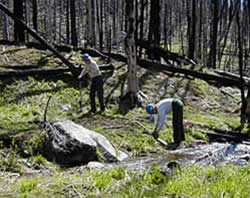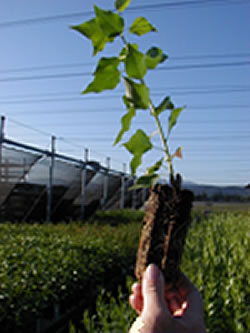What Are Native Plant Materials?
Native plants are the indigenous terrestrial and aquatic species that have evolved and occur naturally in a particular region, ecosystem, and habitat. Species native to North America are generally recognized as those occurring on the continent prior to European settlement. They represent a number of different life forms, including conifer trees, hardwood trees and shrubs, grasses, forbs, and others.
 Planting crews re-establish aspen and other native species to a burned area.
Planting crews re-establish aspen and other native species to a burned area.
 A seed production field of bottlebrush squirreltail, an important restoration species in the western United States.
A seed production field of bottlebrush squirreltail, an important restoration species in the western United States.
 Seeds are stored for future use, a practice referred to as "seed banking".
Seeds are stored for future use, a practice referred to as "seed banking".
 An aspen seedling ready for outplanting. The seedling was vegetatively propagated from root segments that were dug and cut from a mature tree.
An aspen seedling ready for outplanting. The seedling was vegetatively propagated from root segments that were dug and cut from a mature tree.
 Collecting cottonwood cuttings to replant a wildfire area. Cuttings may be outplanted directly, or grown in a nursery to develop root systems prior to planting.
Collecting cottonwood cuttings to replant a wildfire area. Cuttings may be outplanted directly, or grown in a nursery to develop root systems prior to planting.
After disturbances such as wildfires, floods or road construction, native plants often regenerate and recover naturally when conditions are favorable. When natural recolonization is not likely to occur within desired timeframes, however, active restoration with plant materials (seeds, cuttings, nursery stock) may be necessary. The type of plant material used on a particular site will depend on the biology of the target native species, time constraints, the objectives of the planting project, and other factors.
Propagation from seed is the most commonly used method for producing native plant materials. It is often the easiest and most economical method for generating a large number of plant propagules. Propagation from seed may be the only option for regenerating certain species, and can be a way to avoid some plant diseases. An additional advantage is that seeds of most native species can be stored for several years until they are needed for project work.
A disadvantage of seed propagation is that many wildland plants do not produce good seed crops each year. This makes it difficult to obtain sufficient quantities of seed for large projects or for unplanned disturbances such as wildfires, where plant materials must be obtained in a short period of time. A solution to this problem is to establish wildland-collected seed in agronomic environments where plants can be irrigated and cultured for maximum seed production. The field-increased seed can then be warehoused for future use, a practice referred to as “seed banking”.
Plant materials for some native species, such as aspen, cottonwood and many other hardwood tree and shrub species, are best obtained by vegetative propagation methods. In addition to leaf, stem, or root cuttings, other vegetative propagation methods include layering, division, grafting, budding and tissue culture. These latter methods can be difficult and time consuming to perform, and often require special equipment and structures.
Depending on the needs of the revegetation project, vegetative propagules can be outplanted as unrooted cuttings, or rooted cuttings or seedlings that have been grown in a nursery. For smaller projects, plants can be salvaged and transplanted directly from the wild.
Regardless of the propagation method, plant materials must be genetically suited to the specific environment where they will be planted. Native plant materials that meet this standard are called locally adapted.
Other Resources and Links
- An Introduction to Using Native Plants in Restoration Projects (PDF, 806 KB)
- Propagation Protocol Database
The Forest Service and the Smithsonian Environmental Research Center Finalize a Memorandum of Understanding (MOU) for the Conservation and Management of Native Plants

On December 9, 2014, The Director of the Smithsonian Environmental Research Center and the Chief of the Forest Service finalized a new service-wide Memorandum of Understanding (MOU). This MOU recognizes the mutual interest in the conservation and management of native plants, especially native orchids. The Smithsonian, through its North American Orchid Conservation Center (NAOCC), leads a coalition of organizations dedicated to conserving the diverse orchid heritage of the U.S. and Canada. The initial groups of public and private organizations that support NAOCC have joined forces with a common goal: to ensure the survival of native orchids for future generations. To this end, the NAOCC’s collaborators are working to preserve habitats; create and maintain national collections of seeds and orchid mycorrhizal fungi; and support research on orchid ecology, conservation, and restoration.
Western Center for Native Plant Conservation and Restoration Science
RMRS and PNW field crews training on data collection at bluebunch wheatgrass experimental plot at Central Ferry, WA (Photo by: Holly Prendeville, PNW Research Station).
The health of ecosystems across the West is increasingly impacted by many factors including climate change and drought. This is challenging land managers with a pressing need for more science-based, integrated restoration methods. To meet that challenge, scientists from the three western U.S. Department of Agriculture, Forest Service’s research stations – Pacific Northwest (PNW), Pacific Southwest (PSW), and Rocky Mountain (RMRS) Research Stations – chartered a collaborative group called the Western Center for Native Plant Conservation and Restoration Science (WCNP).

